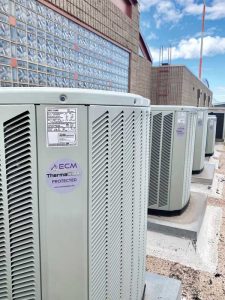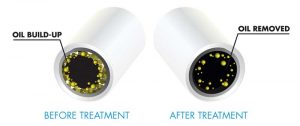
The refrigerant-oil relationship is critical for maintaining system efficiency and preventing equipment breakdowns. Under normal circumstances, there will always be a small amount of oil that escapes a compressor’s crankcase and is circulated with the refrigerant throughout the system. For this reason, refrigerant oil and the refrigerant itself must be miscible.
The miscible mixture enables flowing refrigerant to continuously circulate oil through the system, returning most of the oil back to the compressor sump. However, over time, some of the oil begins to build up and form a thin film on the heat exchanger coils. This slow buildup of migrated oil is referred to as oil-fouling.
Oil-fouling is a common problem 99 percent of HVAC systems experience, resulting in significant reduction of efficiency. Over time, the accumulation of oil and other contaminants in the system’s heat exchanger can impede refrigerant flow, resulting in lower refrigerant velocity that compounds the problem of additional oil buildup. Inadequate refrigerant flow velocity enables oil to drop out of the flow, adhering to the heat exchanger coils. Additional oil buildup leads to poor heat transfer and decreased cooling capacity. This can result in equipment operating at 70 percent or less of its original capacity, leading to substantial energy loss and increased operating costs.
The buildup of oil and other contaminants within the heat exchanger coils means less oil in the compressor sump. This insufficient amount of oil can cause the mechanical moving parts of the compressor to suffer higher frictional loads, which in return could lead to system breakdowns and increased maintenance costs. As such, addressing oil-fouling is a critical step toward optimizing HVAC system performance and reducing energy consumption.
Reclaiming lost efficiency

To address the challenge posed by HVAC systems’ energy consumption and their contribution to carbon emissions, new advanced technologies are being introduced. Material science advances are yielding HVAC performance gains through wear-resistant additives to refrigerant oils, combined with refrigerant specific stabilizers, which are essential to maintaining material properties for the life of the equipment.
In addition to bolstering the refrigerant-specific oil properties, tailored additives that release oil from the heat exchanger surface also enable improved refrigerant velocities and strengthen heat transfer properties. These validated chemical cocktails offer facility managers an innovative way to restore lost efficiency and reduce carbon emissions.




